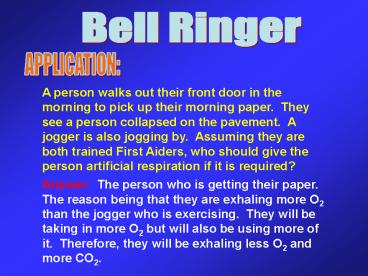Bell Ringer - PowerPoint PPT Presentation
1 / 11
Title:
Bell Ringer
Description:
Assuming they are both trained First Aiders, who should give the person ... in lung is less than in capillaries, therefore, CO2 diffuses into the alveolus. ... – PowerPoint PPT presentation
Number of Views:26
Avg rating:3.0/5.0
Title: Bell Ringer
1
Bell Ringer
APPLICATION
A person walks out their front door in the
morning to pick up their morning paper. They see
a person collapsed on the pavement. A jogger is
also jogging by. Assuming they are both trained
First Aiders, who should give the person
artificial respiration if it is required?
Answer The person who is getting their paper.
The reason being that they are exhaling more O2
than the jogger who is exercising. They will be
taking in more O2 but will also be using more of
it. Therefore, they will be exhaling less O2 and
more CO2.
2
Oxygen and Carbon Dioxide Transport
Methods of O2 transport
- Blood plasma 1
2. Erythrocytes (Hemoglobin) 99
- Erythrocytes (Hemoglobin) 99
Methods of CO2 transport
- Blood plasma 5 10
2. Erythrocytes (Hemoglobin) 20
3. Bicarbonate (HCO3-) 70
- Bicarbonate (HCO3-) 70
We will be concentrating on the two most
important methods
.
.
.
The Respiratory System
3
Oxygen and Carbon Dioxide Transport
protein found in erythrocytes (RBCs) that
functions mainly as an oxygen carrier (CO2 as
well)
Hemoglobin
Each hemoglobin molecule contains 4 Heme groups
that each bind one molecule of oxygen (4 O2
total).
The Respiratory System
4
Oxygen Transport - Blood
Oxyhemoglobin
hemoglobin with O2 bound (brighter red)
Deoxyhemoglobin
hemoglobin without O2 bound
Factors that affect O2 binding to hemoglobin
1. PO2
?PO2 ? ? O2 bound
2. Blood pH
?pH ? ?H (inhibit O2 binding) ? ?O2 bound
3. Temperature
?T ? ?O2 bound
Effects of exercise
Heat generation by working muscles
?H (lactate accumulation)
?O2 bound ? ?O2 unloading (to tissues for work!)
The Respiratory System
5
Oxygen Transport - Muscle
The main oxygen transporting mechanism in muscles
is myoglobin.
- Myoglobin is an oxygen carrying protein similar
to hemoglobin that binds O2 more efficiently than
even hemoglobin.
- Myoglobin is found in abundance in slow twitch,
oxidative fibres
- Myoglobin O2 stores may serve as a reserve for
rest ? exercise transition periods (during the
lag phase) before the cardiopulmonary system
kicks in.
6
Carbon Dioxide Transport
Bicarbonate mechanism (tissue)
CO2 diffuses into erythrocytes where it combines
with water to form carbonic acid (unstable) which
dissociates into a bicarbonate ion and a
hydrogen ion.
CO2
H2O
H2CO3
H
HCO3-
bicarbonate ion
(reaction goes towards right)
The H binds with hemoglobin, and the HCO3-
diffuses out into the plasma. Cl- moves into the
erythrocytes to maintain neutral charge (chloride
shift).
The Respiratory System
7
Carbon Dioxide Transport
Bicarbonate mechanism (tissue)
The Respiratory System
8
Carbon Dioxide Transport
Bicarbonate mechanism (lung)
PCO2 in lung is less than in capillaries,
therefore, CO2 diffuses into the alveolus. O2
diffusing from lung to capillary releases H from
hemoglobin which combines with the bicarbonate to
form carbonic acid (unstable) which quickly forms
CO2 and H2O.
CO2
H2O
H2CO3
H
HCO3-
bicarbonate ion
(reaction goes towards left)
This process helps rid the blood of CO2 that has
been produced by body tissues during cellular
respiration.
The Respiratory System
9
Carbon Dioxide Transport
Bicarbonate mechanism (lung)
The Respiratory System
10
Ventilation and Blood pH
The chemical reaction shown below is reversible.
Which direction the reaction proceeds depends on
the availability (amounts) of reactants.
i.e. large amt. of CO2 and H2O will push the
reaction to the right
large amt. of H and HCO3- will push the reaction
to the left
This process helps regulates pH in the blood
which is slightly basic pH 7.4.
During exercise ?
?CO2(blood), ?H ? ? pH
The Respiratory System
11
Ventilation and Blood pH
During exercise
?CO2 in blood (increased cellular resp.)
Result
?H ? ? pH
To help the body restore pH level the body is
stimulated to increase ventilation.
?VE ? ? CO2 in blood (expirated through lungs)
Result
? CO2 ? ?H ? ?pH
During maximal exercise, ?H due to lactate
production. Increased ventilation helps to
maintain/restore pH by helping to eliminate
excess H by formation of carbonic acid and CO2.
The Respiratory System































